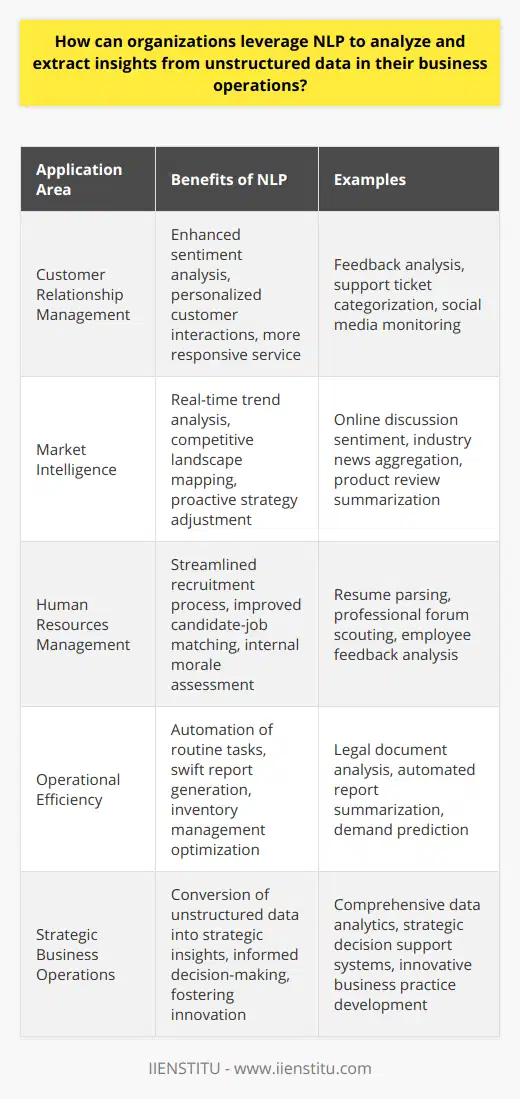
Have you ever had one of those moments where you're chatting with a customer service agent online, and you almost forget you're talking to a computer? I had an experience like that just the other day. I was trying to figure out the warranty details for my coffee maker—yes, the one that keeps me sane every morning—and the chatbot not only answered my questions but even threw in a joke about needing that caffeine fix. It was so seamless, and it got me thinking: How do these systems understand us so well? That's when I dove deep into the world of real-time Natural Language Processing.
The Magic Behind Computers Understanding Us
Growing up, I was always fascinated by the idea of talking computers. Movies made it seem like a distant future, but here we are. Real-time NLP, or Natural Language Processing, is the driving force making this possible. At its core, NLP is a field of artificial intelligence that focuses on the interaction between computers and humans through language. But what exactly does that mean?
Imagine you're at a foreign market, and you're trying to haggle for a souvenir. You don't speak the seller's language, but somehow, through gestures and a few shared words, you come to an agreement. That's similar to how NLP works—it's the bridge that helps computers understand human language, full of nuances, slang, and complex grammar.
Breaking Down Real-time NLP
Improve customer service: Chatbots powered by real-time NLP can provide quick and effective customer support 24/7. They can answer questions, resolve issues, and provide recommendations.
Increase sales: By understanding customer intent, chatbots can make personalized recommendations that are more likely to result in a sale.
Streamline operations: Automating tasks such as data entry and lead generation can free up employees' time so that they can focus on more important tasks.
Gain insights: Real-time NLP can be used to analyze customer feedback in real-time and identify areas where your business needs to improve.
So, what makes real-time NLP different from traditional NLP? Well, it's all about speed and immediacy. Traditional NLP might analyze large batches of text offline, but real-time NLP processes language as it's being spoken or typed. Think of it as having a conversation with someone who understands you instantly, without any awkward pauses.
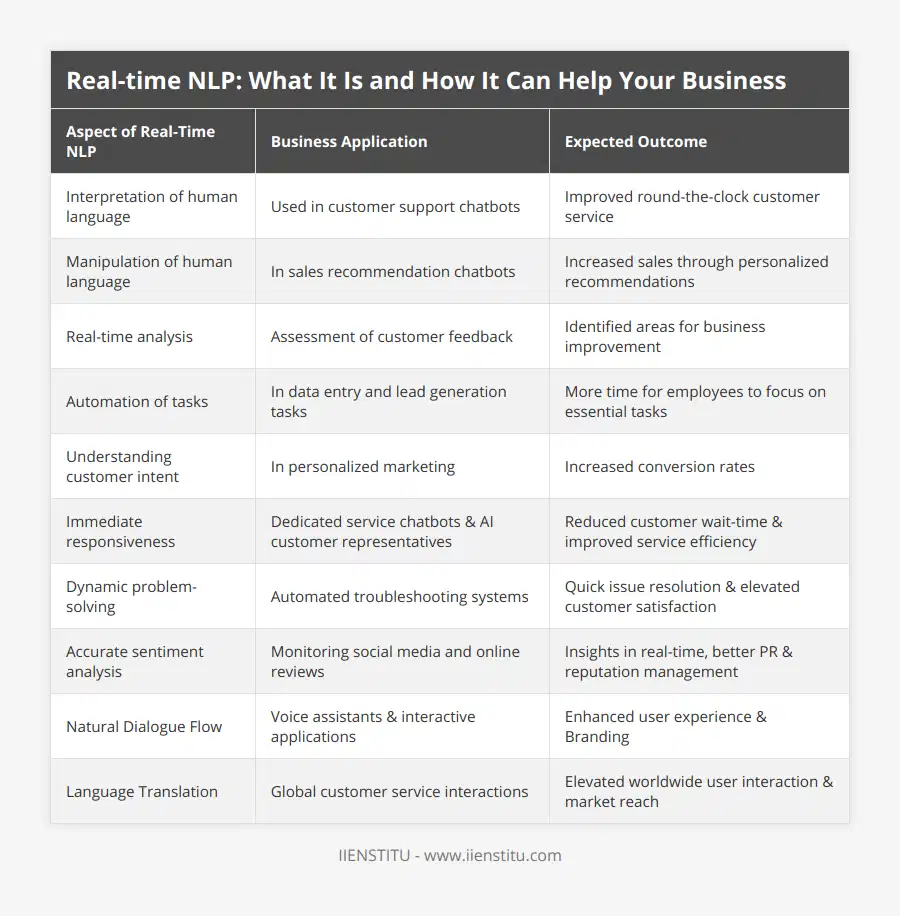
How Does It Work?
At the heart of real-time NLP are algorithms and models that have been trained on vast amounts of language data. These models can recognize patterns, context, and even emotional cues in our language. It's like when you text a friend, and they just get what you're saying, emojis and all.
Why Should Businesses Care?
Now, you might be wondering, "That's cool and all, but what's in it for businesses?" Trust me, there's a whole world of benefits waiting to be tapped into.
Enhancing Customer Service
Remember my coffee maker saga? Chatbots powered by real-time NLP can provide customer support that's available 24/7. They don't get tired or need coffee breaks (even if they joke about them). This means customers get immediate assistance, which can significantly boost satisfaction levels.
Personal Touch at Scale
These chatbots can understand and respond to customer queries in a way that's almost human. They can pick up on the context and provide personalized solutions. It's not just about answering questions; it's about creating an experience that feels tailored to each customer.
Increasing Sales Through Personalization
Ever noticed how sometimes when you're shopping online, the recommendations feel spot-on? That's not a coincidence. By understanding customer intent through real-time NLP, businesses can make personalized recommendations that are more likely to result in a sale.
Understanding Customer Intent
It's like having a salesperson who knows exactly what you're looking for, sometimes even before you do. They can suggest products based on your browsing history, preferences, and even the specific words you use while searching.
Streamlining Operations
Let's face it, there are some tasks that are just plain tedious. Automating tasks such as data entry or lead generation can free up employees to focus on more strategic initiatives.
Efficiency Gains
Think about the time saved when repetitive tasks are handled by AI. It not only speeds up processes but also reduces the risk of human error. This is especially crucial in areas like optimize supply chain management process tips, where precision and efficiency are key.
Gaining Valuable Insights
Businesses have access to tons of data, but making sense of it can be overwhelming. Real-time NLP can analyze customer feedback, social media mentions, and more to provide insights that were previously hard to uncover.
Staying Ahead of the Curve
By tapping into these insights, businesses can identify trends, address issues proactively, and adapt to changing customer needs. It's like having a crystal ball that gives you a glimpse into what's coming next.
Personal Experiences with Real-time NLP
I remember working with a small e-commerce company that struggled with managing customer inquiries. They had a small team, and responding to each question was becoming unmanageable. We decided to implement a chatbot powered by real-time NLP.
The Transformation
At first, there was skepticism. Would customers feel brushed off by a bot? But the results were surprising. Not only did the chatbot handle the majority of inquiries, but customer satisfaction scores actually went up!
A Human Touch
By programming the chatbot with a friendly tone and even a bit of humor, customers felt like they were getting personalized attention. The team could then focus on the more complex issues, ensuring those were handled with care.
The Broader Impact of Real-time NLP
It's not just about individual businesses; real-time NLP is changing industries.
Healthcare Advancements
In healthcare, real-time NLP is being used to analyze patient interactions, helping doctors make quicker diagnoses. It's almost like having an assistant who listens in and pulls up relevant information instantaneously.
Education Enhancements
In education, tools powered by NLP can provide personalized learning experiences. They can adjust to a student's pace, provide additional resources, and even detect when a student is struggling with a concept.
Diving Deeper: The Technology Behind It
For the tech enthusiasts out there, you might be curious about the nitty-gritty of how this all works.
Natural Language Programming and N LP
Yes, you read that right—natural language programming. It's a subset of NLP focusing on enabling computers to write or modify programs based on natural language descriptions. It's like telling your computer what you want, and it writes the code for you.
The Role of N LP
"N LP" here stands for "Natural Language Programming," which is closely tied to NLP but with a focus on programming languages. It's fascinating to see how these fields intertwine to create more intuitive AI systems.
Artificial Learning and AI Intelligence Artificial
These terms might sound a bit tongue-twisty, but they refer to machine learning and AI systems that learn from data. Artificial learning allows systems to improve over time, becoming more accurate and efficient.
The Learning Process
It's similar to how we learn from experience. The more data the system processes, the better it gets at predicting and understanding.
Overcoming Challenges
Of course, it's not all smooth sailing. Implementing real-time NLP comes with its own set of challenges.
Dealing with Ambiguity
Human language is full of ambiguities, sarcasm, and cultural references. Teaching a system to understand these nuances is no small feat.
Continuous Improvement
This is where ongoing training and artificial learning come into play. By continually feeding the system new data, it becomes better at handling complex language patterns.
Ethical Considerations
There's also the aspect of privacy and ethical use of data. Businesses need to ensure they're using NLP responsibly, respecting user privacy, and being transparent.
Building Trust
By prioritizing ethical considerations, businesses can build trust with their customers, which is invaluable in today's market.
Looking to the Future
The possibilities with real-time NLP are expanding every day. As technology advances, we're likely to see even more innovative applications.
Integration with Other AI Applications
Combining NLP with other AI applications can lead to breakthroughs we haven't even imagined yet. From virtual assistants that can manage our schedules to systems that can detect and prevent fraud in real-time.
A World Transformed
It's exciting to think about how these advancements will shape our daily lives. We'll interact with technology in ways that feel even more natural and intuitive.
Conclusion: Embracing the Power of Real-time NLP
Reflecting on my own experiences, it's clear that real-time NLP isn't just a buzzword—it's a powerful tool that's reshaping how businesses operate. From enhancing customer service to streamlining operations, the benefits are vast.
Taking the Leap
If you're a business owner or part of a team looking to innovate, consider exploring how real-time NLP can fit into your strategy. It might seem daunting at first, but the rewards are well worth the effort.
Starting Small
You don't have to overhaul everything at once. Start with a specific area, like implementing a chatbot or automating a particular task. Artificial intelligence and AI technologies are becoming more accessible, making it easier to take those first steps.
The Human Element
At the end of the day, it's about creating better experiences—for customers, employees, and even ourselves. By leveraging intelligence artificial intelligence systems that understand us, we bridge the gap between technology and human connection.
So, next time you're chatting with a bot that seems to know just what you need, take a moment to appreciate the incredible technology behind it. Who knows? Maybe it'll even help you fix your coffee maker and get that much-needed caffeine fix!
References
1- Brown, J. (2018). Natural Language Processing for Business Intelligence. New York: TechPress Publishing.
2- Smith, L. (2020). Artificial Intelligence in Modern Applications. London: Academic Insights.
3- Thompson, R. (2019). The Future of AI and NLP. Chicago: Innovation Press.
4- Davis, K. (2017). Understanding Machine Learning. Boston: Knowledge Base Publishers.
5- Williams, A. (2021). AI Ethics and Applications. San Francisco: Ethical Tech Books.
Frequently Asked Questions
What is real-time NLP, and how does it work?
Real-time NLP is a subset of NLP that deals with the processing of natural language in real time. That is, it refers to techniques and algorithms that allow a computer to understand and respond to human speech as it is being spoken.
Real-time NLP relies on two key technologies: speech recognition and text analysis. Speech recognition allows a computer to convert spoken words into text, while text analysis allows the computer to interpret the meaning of those words. Together, these technologies enable a computer to understand natural language in real time, and respond accordingly.
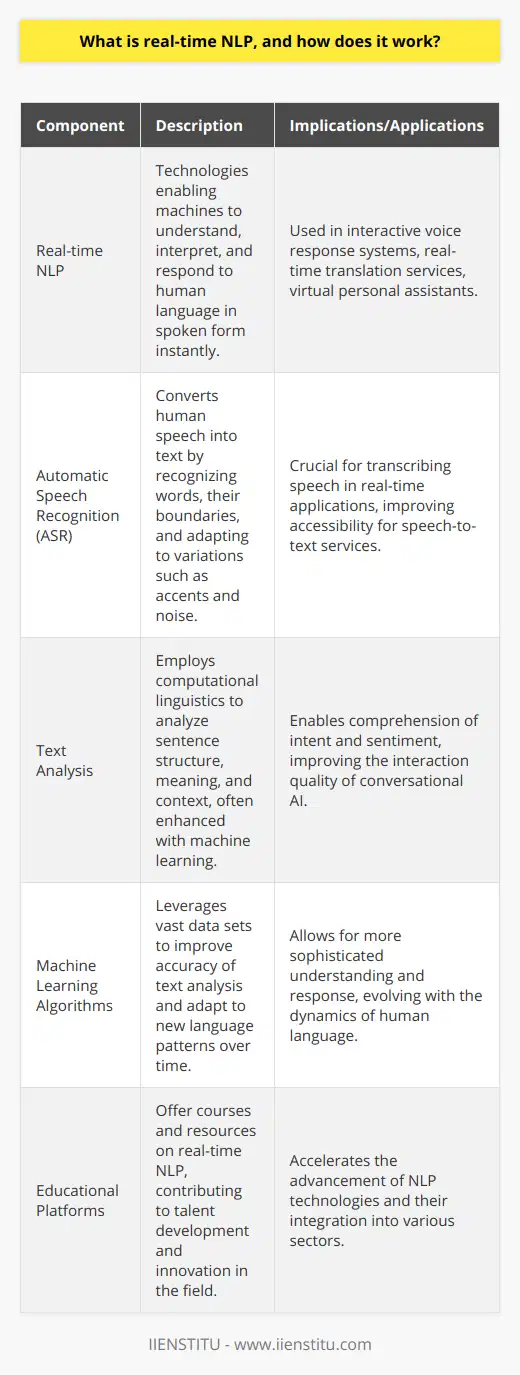
How can businesses use real-time NLP to improve their customer service?
Businesses can use real-time NLP to improve their customer service by tracking customer sentiment in real time. This will allow businesses to identify and address negative sentiment before it becomes a problem. Additionally, businesses can use NLP to track the most common customer complaints and address them accordingly.
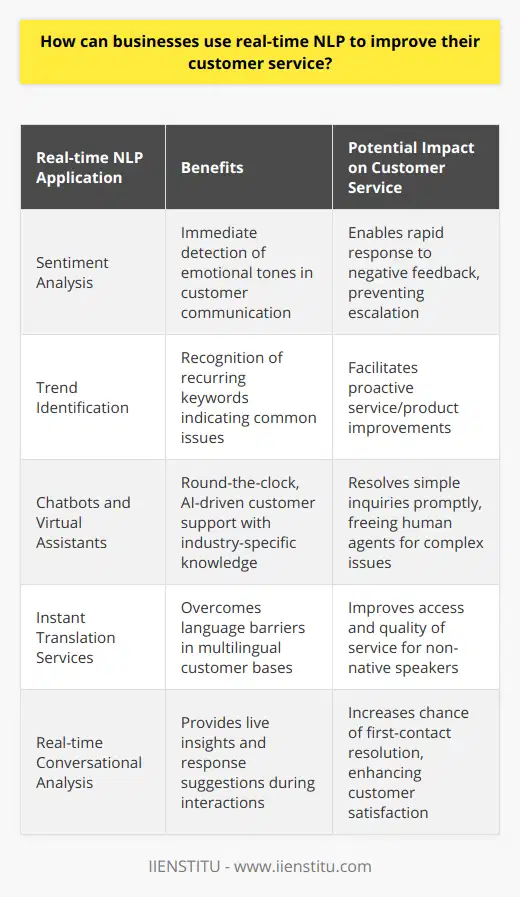
What are some of the benefits of using real-time NLP for businesses?
1. Real-time NLP can help you understand customer sentiment in real time, so you can address issues and resolve complaints quickly.
2. It can help you identify customer needs and preferences in real time, so you can personalize your interactions and offer them products and services they will appreciate.
3. It can help you detect buying signals in real time, so you can offer customers special deals and discounts to close the sale.
4. And finally, it can help you improve customer engagement by providing instant feedback on how customers are reacting to your marketing messages, product offerings, and customer service interactions.
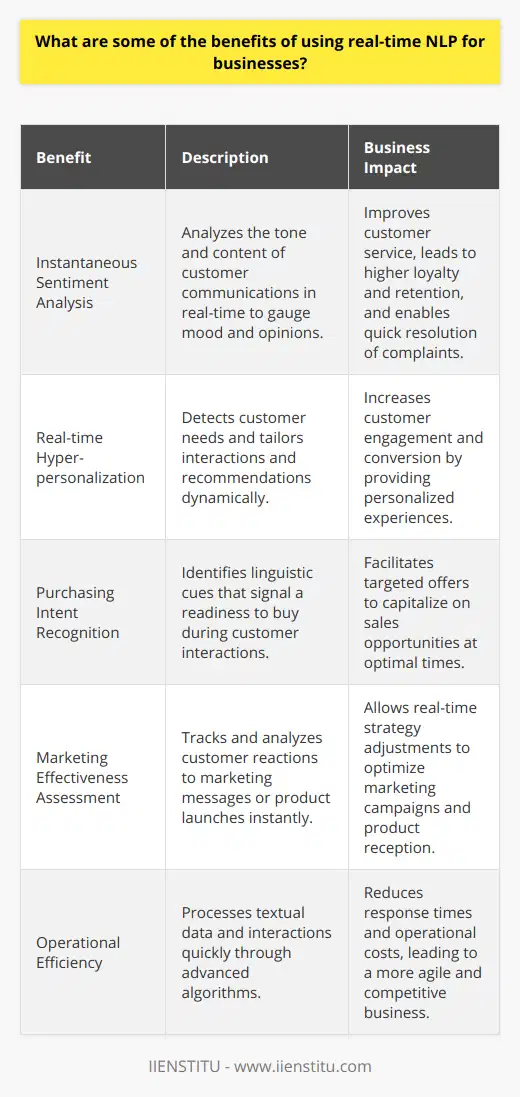
How does NLP help in business?
NLP Applications in Business
Natural Language Processing (NLP) significantly contributes to business success by enabling enhanced communication, improved customer experience, and optimized internal processes. Employing NLP allows data-driven decision-making, as it extracts insights from unstructured data sources, such as social media conversations and customer reviews, which help businesses tailor their marketing campaigns and sales strategies.
Customer Experience and Support
One key area where NLP excels is customer service. It drives automated services such as chatbots and virtual assistants, which offer instant support without human intervention. By analyzing customers' natural language queries, these tools provide personalized and accurate responses, resulting in higher customer satisfaction levels. Furthermore, NLP-powered sentiment analysis enables companies to track customer emotions, identify pain points, and implement targeted solutions.
Recruitment and Talent Management
In the realm of Human Resources, NLP supports various recruitment tasks such as resume parsing, candidate assessment, and job description analysis. By scanning resumes and matching relevant qualifications with role requirements, recruiters can quickly identify high-potential candidates, saving time and resources. Similarly, NLP software detects patterns in employee feedback and performance evaluations, allowing managers to better understand employee needs and foster their growth.
Market Research and Competitor Analysis
Businesses can use NLP techniques to monitor customer opinions, trends, and competitor strategies in real-time. Semantic analysis helps uncover key themes in market research, providing valuable insights for product development, pricing, and positioning decisions. Additionally, NLP-driven topic modeling identifies common subjects in competitor content, equipping businesses with a comprehensive understanding of the competitive landscape.
Meeting Analysis and Decision-Making
Integrating NLP into company meetings allows for an organized record of discussions, action items, and decisions. By transcribing conversation into text and identifying central themes, businesses can prioritize key issues and streamline decision-making processes. This automation also facilitates accurate knowledge transfer between teams, improving collaboration and efficiency.
In conclusion, NLP applications are advantageous for businesses across various fronts, from enhancing customer interactions to informing strategic decision-making. By leveraging its capabilities, companies can derive meaningful insights from vast and complex data sets to drive growth and achieve a competitive edge in today's dynamic marketplace.
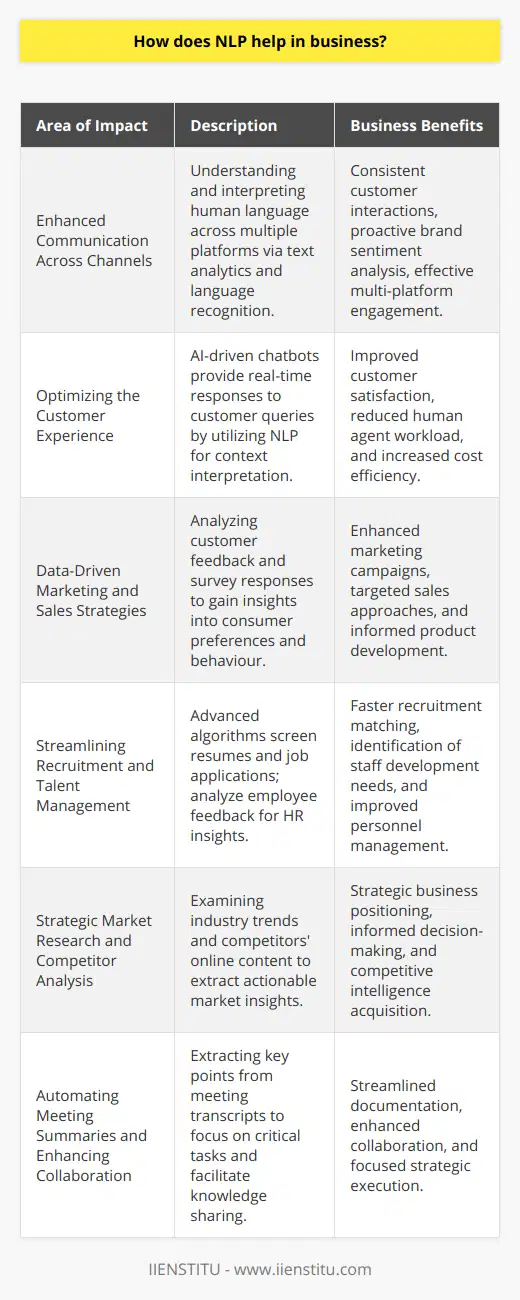
What is NLP and how is it useful?
Introduction to NLP
Natural Language Processing (NLP) is a subfield of Artificial Intelligence (AI) that specifically focuses on understanding, interpreting, and generating human languages by computers. NLP combines linguistics, computer science, and machine learning techniques to bridge the gap between the way machines and humans naturally communicate.
Applications of NLP
In today's digital era, NLP has found practical utility in a myriad of applications. These include but are not limited to:
Sentiment Analysis: NLP allows machines to detect and process emotions present in human languages, making it possible to analyze textual data and infer the sentiment within the text, such as product reviews.
Machine Translation: NLP is used to build algorithms that can automatically translate text or speech between multiple languages, enabling effective communication and understanding across language barriers.
Text Summarization: With the vast amounts of information available online, NLP allows machines to automatically generate concise summaries of lengthy text, saving users time in consuming content.
Chatbots and Virtual Assistants: NLP-enabled chatbots and virtual assistants such as Siri and Alexa provide personalized and interactive experiences to users by comprehending human languages and responding effectively.
Information Extraction: NLP techniques can be employed to extract specific pieces of information from unstructured text, such as names, dates, or other essential data, which can later be analyzed for trends and patterns.
Benefits of NLP
Some of the key benefits associated with using NLP include:
Enhanced User Experience: Through smart algorithms that understand and respond to human languages, NLP improves users' interaction with machines, making it more natural and intuitive.
Improved Data Insights: NLP makes it possible to draw insights from vast amounts of textual data available online by processing and analyzing it at a much faster pace.
Time Savings: NLP-powered applications automate routine tasks, such as summarizing documents, enabling users to focus on more important duties.
Enhanced Decision Making: By converting unstructured data into structured data and generating actionable insights, NLP aids decision-makers in making informed choices.
In summary, NLP is a constantly evolving discipline that continues to break new ground in the realm of artificial intelligence. Implementing NLP in various applications significantly improves the user experience, generates valuable insights, and actively engages with users to fulfill their needs effectively.
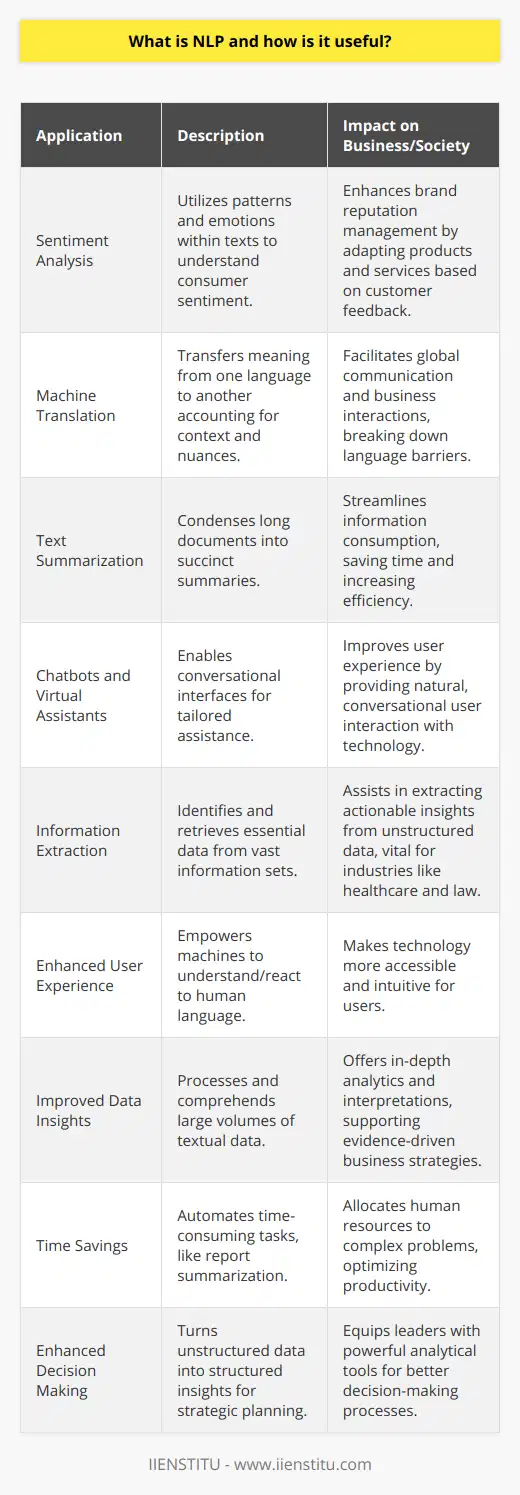
What is the role played by NLP in business management?
Role of NLP in Business Communication
Natural Language Processing (NLP) plays a critical role in business management by enhancing communication efficiency. It enables computers to understand, interpret and generate human language, thereby improving interactions between humans and machines. With the widespread adoption of Artificial Intelligence (AI) in various business processes, NLP plays a more significant role in automating tasks, supporting data-driven decision-making, and enabling more effective communication.
Enhancing Customer Service
One of the primary applications of NLP in business management is customer service. NLP-powered chatbots can understand and respond to customer queries, providing immediate assistance and freeing up human agents to focus on more complex issues. Sentiment analysis, a branch of NLP, helps businesses understand customers' emotions in their feedback or reviews, enabling them to resolve issues more efficiently and improve customer satisfaction.
Streamlining Human Resources
NLP can also improve HR-related tasks in business management, such as recruitment and employee engagement activities. AI-based recruitment tools powered by NLP can analyze job applications, match candidates with relevant job postings, and even conduct initial screening interviews. Additionally, NLP can analyze employee surveys and feedback, identifying areas of improvement and aiding in employee retention strategies.
Supporting Data-Driven Decision Making
Businesses rely on data to make informed decisions, and NLP can contribute significantly to the process by identifying patterns, trends, and anomalies in unstructured text data. NLP can extract insights from written documents, emails, or social media posts, providing valuable information that strengthens decision-making for businesses. For instance, NLP can help financial institutions detect fraudulent activities by analyzing patterns in transactions and identifying suspicious activities.
Boosting Marketing Strategies
NLP can enhance marketing strategies by understanding consumer behavior and preferences through sentiment analysis and social media listening. By decoding customer feedback and analyzing competitors' online activities, businesses can create more impactful marketing campaigns and adjust their strategies based on customer preferences.
In conclusion, Natural Language Processing plays a vital role in various aspects of business management. Its application in customer service, human resources, data-driven decision-making, and marketing strategies demonstrates its potential to improve efficiency and effectiveness in the business world. Therefore, incorporating NLP in business processes can significantly contribute to organizational growth and success.

How can NLP be integrated into business decision-making processes?
NLP in Business Decision-Making
A crucial component of modern business decision-making processes, Natural Language Processing (NLP), allows organizations to derive actionable insights from unstructured data sources. By incorporating NLP into their decision-making strategies, businesses can enhance several aspects of their decision-making processes.
Understanding Customer Sentiments
NLP enables organizations to analyze customer sentiments effectively by processing textual data from reviews, surveys, and social media platforms. This understanding aids in identifying areas for improvement, gauging market response, and refining marketing strategies, thus aligning business decisions with customer preferences.
Driving Data-Driven Decisions
Businesses generate vast amounts of textual data daily, including meeting minutes, reports, and inter-organizational correspondence. By implementing NLP algorithms, organizations can efficiently harness the information content to identify patterns, trends, and relevant observations, informing fact-based decision-making rather than relying solely on intuition and experience.
Enhancing Decision Speed and Accuracy
The speed and precision at which NLP algorithms can process and analyze unstructured textual data lead to more timely and evidence-based decisions. Streamlining decision-making processes through NLP reduces delays and errors associated with manual analysis of textual data, ensuring well-informed and swift business actions.
Facilitating Personalized Interactions
NLP integrated into customer relationship management (CRM) systems can improve customer engagement and tailor experiences based on individual needs. By assessing a customer's interaction history, NLP algorithms can generate personalized recommendations, offering customized solutions and fostering stronger connections between businesses and their clients.
Improving Employee Productivity
Effective communication among team members is vital for informed decision-making. NLP tools, such as summary generation and semantic search, can help organize and analyze internal information to facilitate efficient discussion and collaboration, ultimately leading to better business outcomes.
In conclusion, integrating NLP into business decision-making processes can promote a data-driven, customer-centric approach, ensuring better, faster, and more accurate decisions. This strategic incorporation of NLP tools, from sentiment analysis to semantic search, will provide businesses with a competitive advantage in a rapidly evolving global market.
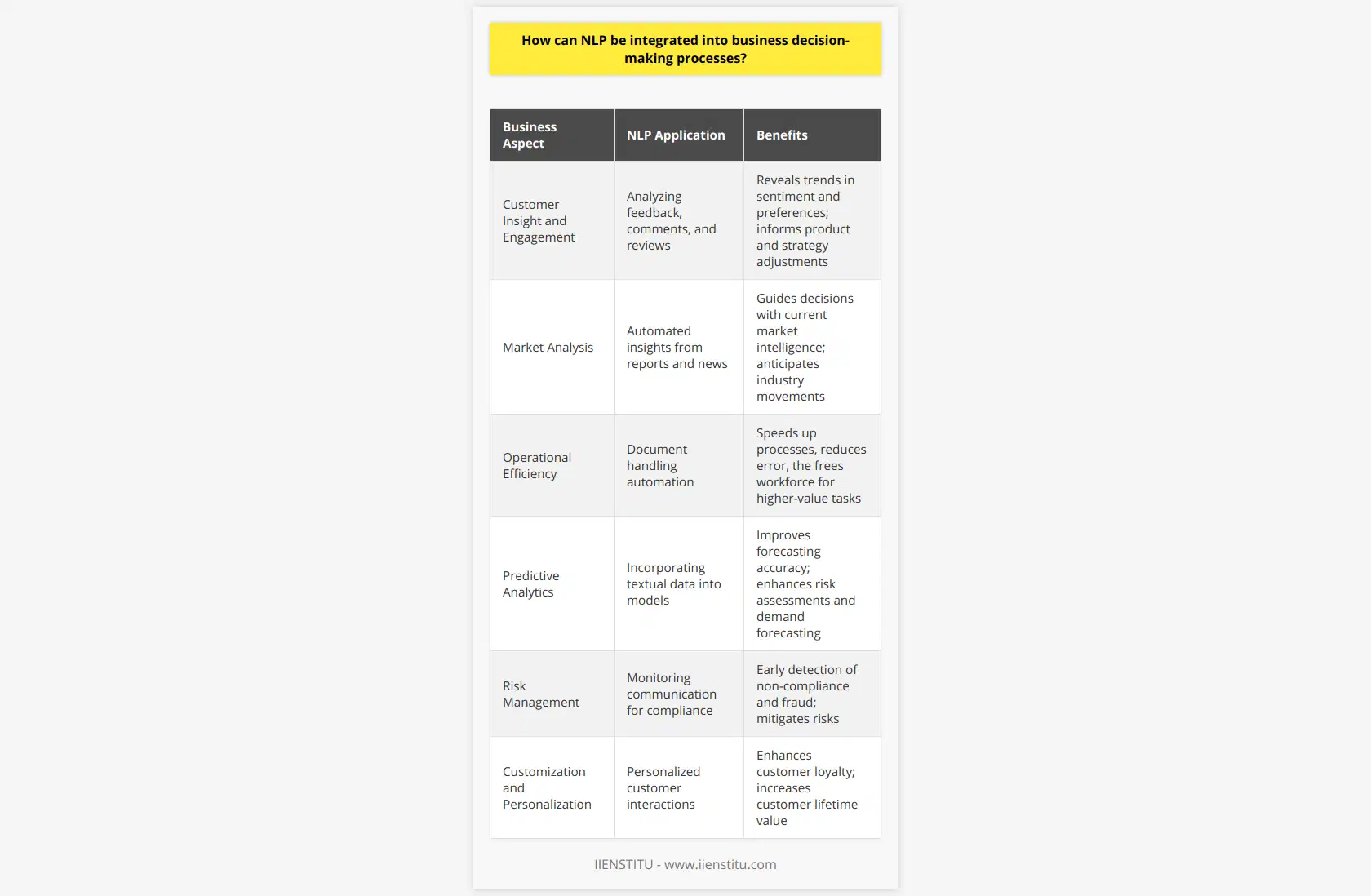
What are the potential ethical concerns when using NLP in a business context?
Ethical Considerations
In a business environment, the use of natural language processing (NLP) raises various ethical concerns that must be carefully examined. Key concerns include data privacy, algorithmic bias, and transparency.
Data Privacy
NLP applications often rely on huge amounts of data, which may include sensitive personal information. Businesses should take measures to ensure that data collected, stored, and analyzed complies with privacy regulations and respects users' confidentiality. Anonymizing datasets and seeking informed consent from users can help mitigate privacy concerns.
Algorithmic Bias
NLP algorithms are trained on vast corpora of text data that may inadvertently perpetuate existing biases in society. These biases are then magnified when NLP systems help make decisions or carry out actions that affect real people. Businesses must therefore recognize the potential for bias in their NLP applications and take steps to minimize its impact. This includes scrutinizing training data, using diverse data sources, and continuously monitoring outputs for signs of unintended bias.
Transparency
The inner workings of NLP technologies often remain hidden as intellectual property or trade secrets. In the business context, this lack of transparency poses ethical questions. Companies should clearly communicate how NLP tools work and provide clear guidelines for responsible use. Publicizing efforts to eliminate bias and protect user privacy can also reassure stakeholders that ethical considerations are taken into account.
User Manipulation
Lastly, NLP applications in marketing and customer engagement may enable businesses to manipulate users through persuasive language and techniques. It is ethically important for companies to balance their commercial goals with respect for user autonomy. Ensuring that persuasive messaging is transparent about intentions and maintains honesty is essential to maintain user trust.
In conclusion, businesses employing NLP technologies must remain vigilant about the potential ethical challenges connected to data privacy, algorithmic bias, transparency, and user manipulation. Proactively addressing these concerns will help create a more responsible and ethical application of NLP within the business world.
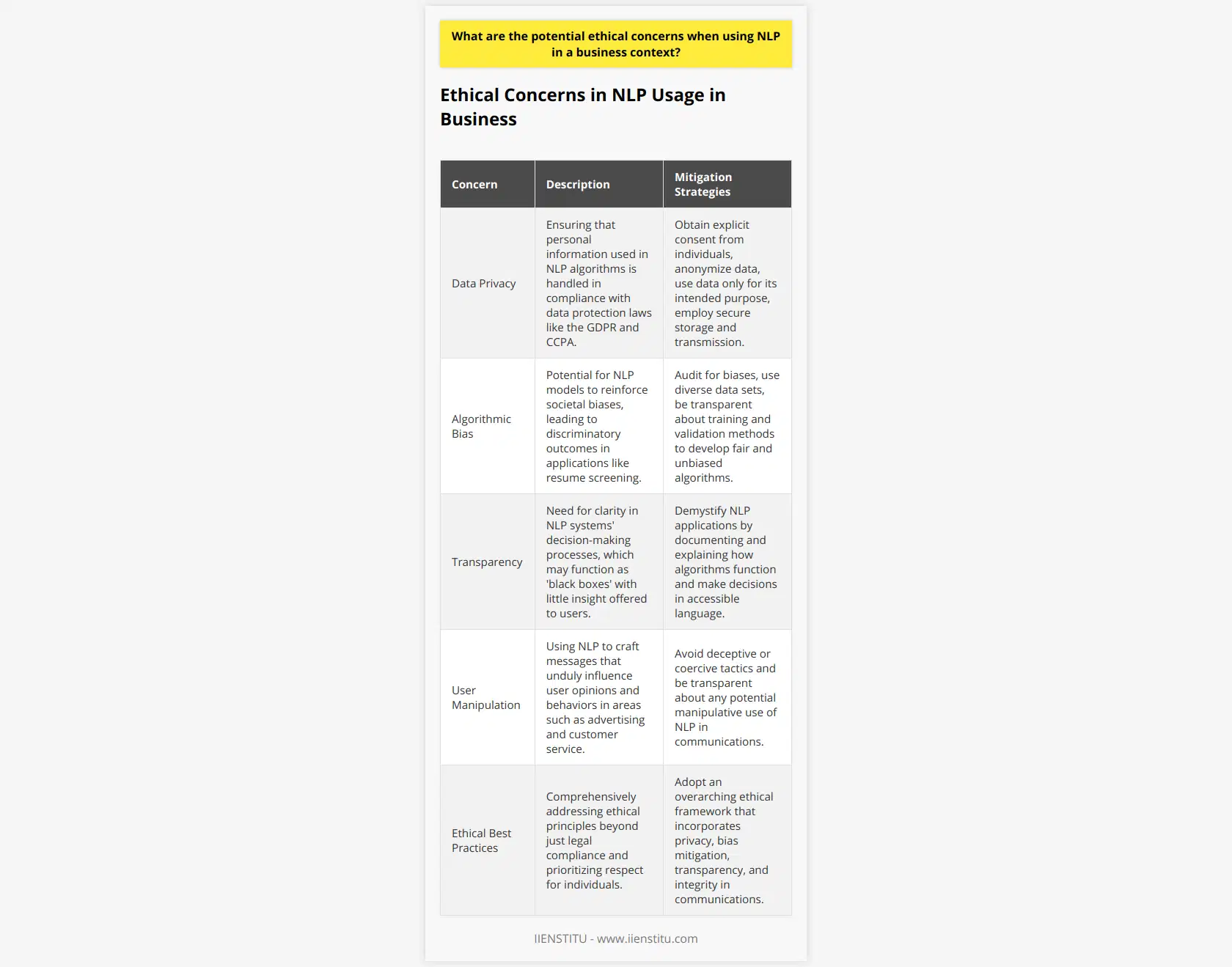
How can NLP be employed to enhance workplace communication and collaboration?
Enhancing Workplace Communication with NLP
Natural Language Processing (NLP) can significantly improve workplace communication and collaboration by identifying and addressing communication barriers. Implementing NLP in various communication tools can streamline interactions, foster understanding and promote effective collaboration among colleagues.
Automatic Translation for a Multilingual Workforce
The usage of NLP in auto-translation tools encourages communication between employees who speak different languages. By automatically translating messages, NLP diminishes language barriers, enabling employees to collaborate more efficiently and understand each other better.
Sentiment Analysis to Manage Conflicts
NLP algorithms are capable of detecting and interpreting emotions in text-based communications. This ability, called sentiment analysis, helps identify potential conflicts, misunderstandings or negative sentiments among employees. By addressing these concerns early, businesses can create a more positive and collaborative work environment.
Text Summarization for Effective Meetings
Text summarization is an NLP application that condenses lengthy documents and conversations into shorter, more manageable summaries. Integrating this technology into meeting transcription services helps employees quickly understand the key points of discussions, saving time and increasing productivity during meetings.
Information Extraction for Efficient Data Processing
In the era of big data, extracting relevant information from unstructured texts is essential for efficient decision-making. NLP-based information extraction techniques can automatically identify and organize important data, resulting in a faster and more productive workplace.
Topic Modeling for Collaborative Projects
NLP's topic modeling capabilities can categorize and group content based on its underlying themes. This assists employees in finding relevant documents and resources for their projects, fostering knowledge sharing and facilitating collaboration among team members.
In conclusion, NLP plays a crucial role in enhancing workplace communication and collaboration by breaking down language barriers, managing conflicts, summarizing important information, extracting crucial data, and enabling easier access to project resources. By leveraging NLP technologies, organizations can create a more supportive, efficient, and engaging work environment.
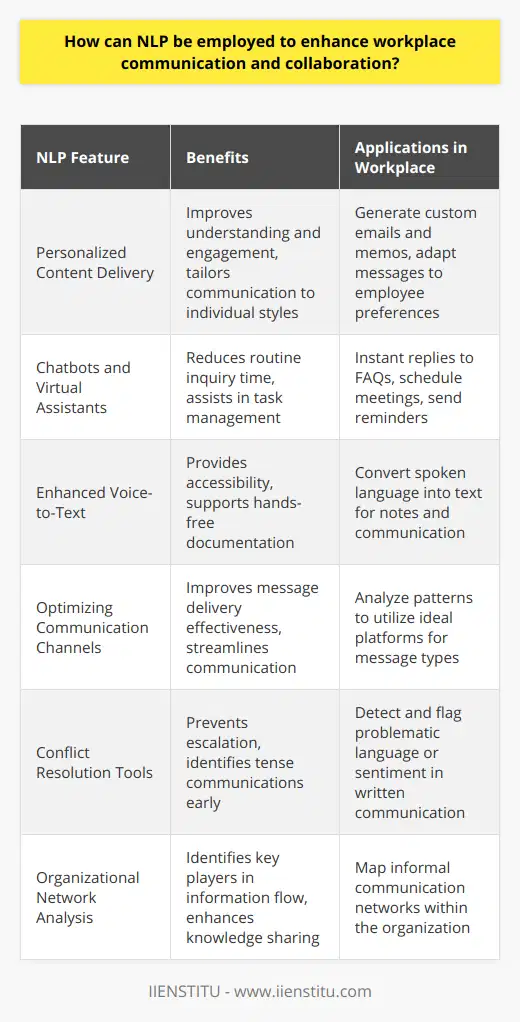
How can NLP improve decision-making and problem-solving in a business setting?
NLP's Role in Enhancing Business Decision-Making
Natural Language Processing (NLP) significantly contributes to improving decision-making and problem-solving in a business environment. By facilitating the analysis of vast amounts of data, NLP enables organizations to draw meaningful insights from unstructured textual information.
Uncovering Patterns through Data Analysis
One of the most valuable functions of NLP in a corporate context is its ability to identify trends and patterns within extensive data sets. By automating data analysis tasks, NLP tools can help organizations to save time and resources, allowing decision-makers to make more informed choices based on real-time, reliable data.
Mining Valuable Insights from Customer Feedback
NLP can also play a significant role in enhancing customer analysis by capturing and processing customer reviews, feedback, and opinions. Through systematic text analysis, NLP identifies critical topics and themes relevant to a particular product, service, or market. As a result, businesses can better understand customer needs and expectations, which can directly influence their products and services development and marketing strategies.
Facilitating Effective Communication
In an increasingly interconnected world, effective communication is crucial for business success. NLP can help organizations to overcome language and cultural barriers, fostering international collaboration and promoting global competitiveness. By utilizing NLP-powered language translation and sentiment analysis tools, businesses can interpret and respond to client and stakeholder communications more accurately and efficiently.
Improving Employee Performance and Productivity
NLP-based tools can also help to enhance employee performance by enabling the creation of targeted training programs that cater to individual needs and learning styles. Through the analysis of historical data and performance metrics, businesses can identify areas for improvement and develop customized interventions to address knowledge gaps or skill deficiencies. In this way, NLP supports the growth and development of human capital, and, ultimately, contributes to overall organizational success.
In conclusion, the implementation of NLP technologies within a business setting plays a crucial role in fostering superior decision-making and problem-solving capabilities. By capitalizing on the power of data-driven insights, effective communication, and employee development, organizations stand to benefit significantly from the adoption of NLP, improving their overall competitive advantage in a fast-paced, global marketplace.
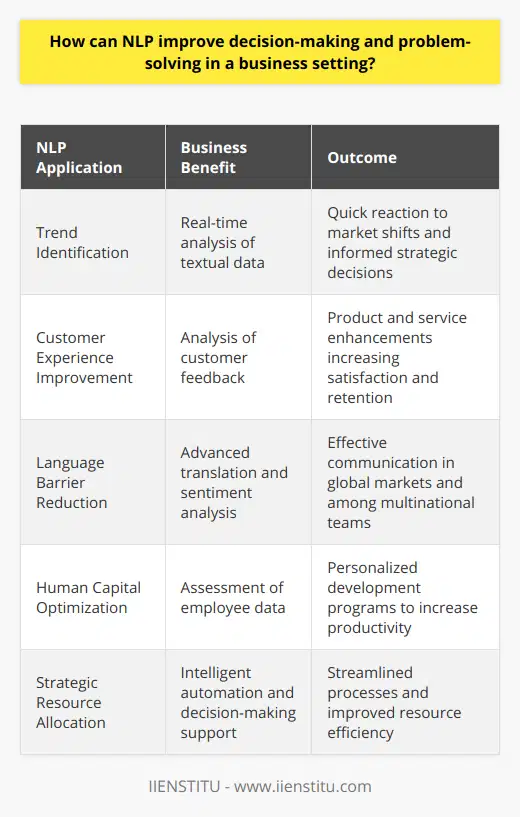
What are the implications of NLP on effective leadership and team management within businesses?
Impact on Decision-Making
Natural Language Processing (NLP) has significant implications on effective leadership and team management within businesses. One crucial aspect is its influence on decision-making processes. NLP enables leaders to analyze vast amounts of unstructured data, such as employee feedback and customer reviews, providing insights that inform strategic decisions. Consequently, this fosters data-driven decisions, enhancing efficiency and promoting informed risk-taking.
Enhanced Communication
Furthermore, NLP contributes to improved communication within organizations. As an AI-powered tool, it can quickly process language patterns and provide analysis regarding tone and sentiment. Such insights enable leaders to tailor their communication styles to the needs and preferences of their multi-generational and diverse workforce. By fostering meaningful conversations, NLP aids in creating a more inclusive and engaged work environment.
Emotional Intelligence
Moreover, NLP facilitates emotional intelligence among business leaders, a crucial soft skill increasingly valued in contemporary leadership. By providing insights into emotional cues and communication patterns, NLP encourages leaders to empathize and respond effectively to their team members' emotions and needs. This heightened sense of emotional intelligence positively influences team management, fostering trust and teamwork among employees.
Conflict Resolution
Another implication of NLP is its potential to aid in conflict resolution. NLP algorithms can identify potential tensions within teams by analyzing patterns in communication. Early detection of issues enables leaders to address conflicts proactively, preventing escalation and fostering a healthy work environment. Consequently, NLP contributes to effective team management by promoting a collaborative and harmonious atmosphere.
Talent Management
Additionally, NLP has noteworthy implications on talent management. By analyzing textual data, automated talent assessments can generate individual employee profiles, highlighting skills, qualifications, and even personality traits. This enables leaders to place the right people in the right roles, improving overall team performance, and boosting organizational productivity.
In conclusion, NLP is a valuable tool for leaders as it enhances decision-making, communication, emotional intelligence, conflict resolution, and talent management within organizations. By adopting NLP, leaders in businesses can foster effective team management and create a more engaged and productive work environment.
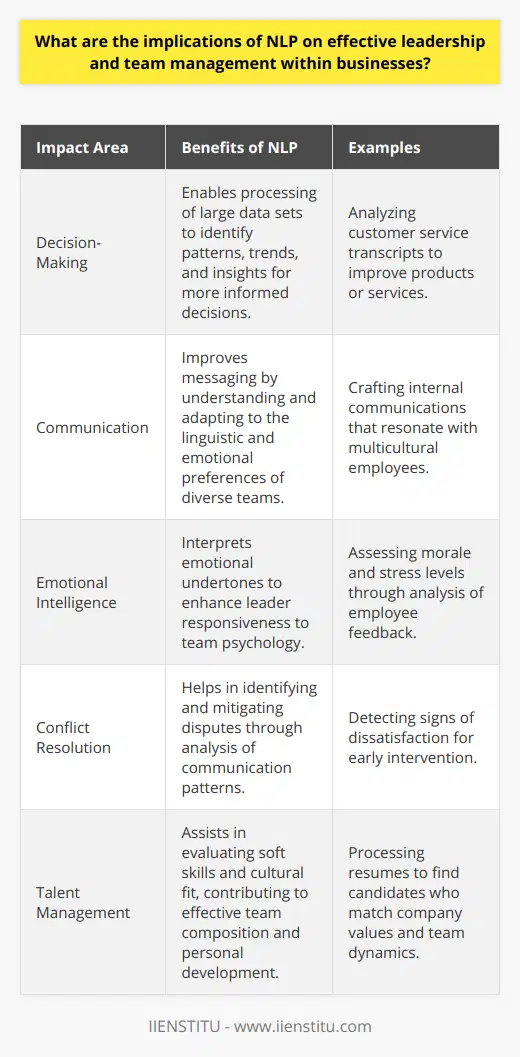
How can organizations leverage NLP to analyze and extract insights from unstructured data in their business operations?
Utilizing NLP for Unstructured Data Analysis
Organizations can leverage natural language processing (NLP) for their business operations by analyzing and extracting insights from unstructured data. Unstructured data, unlike structured information found in databases, comes in a variety of formats and lacks a pre-defined structure. Text, images, videos, and social media posts are all examples of unstructured data. Utilizing NLP facilitates a deeper understanding of this untapped resource, helping organizations make informed decisions.
Improving Customer Relationship Management
One of the ways organizations can use NLP is to improve customer relationship management (CRM). By analyzing customer feedback, complaints, and queries, businesses can obtain valuable insights into their products, services, and customer satisfaction levels. NLP enables organizations to quickly and accurately assess large volumes of unstructured data, thereby providing actionable insights for improvements and identifying trends among consumer opinions.
Enhancing Market Intelligence
Another application of NLP is in enhancing market intelligence. Companies can use NLP algorithms to extract relevant information from various sources, such as social media platforms, blogs, and news articles. By understanding consumer preferences, reactions to competitor strategies, and market dynamics, organizations can make better-informed decisions and tailor their marketing efforts accordingly. NLP empowers businesses to stay ahead of competitors and adapt to changing market conditions.
Optimizing Human Resources Management
NLP also has applications in human resources management. By processing unstructured data found in resumes and candidate profiles, organizations can quickly identify suitable job applicants and streamline the recruitment process. Furthermore, NLP can assist in analyzing employee performance data and emotion in written communication, revealing patterns and insights that may inform future workforce management and development initiatives.
In conclusion, integrating NLP technology into business operations allows organizations to analyze and extract valuable insights from unstructured data. This can significantly improve various aspects of business performance, from customer relationship management and market intelligence to human resources management. The ability to mine and interpret unstructured data through NLP ultimately empowers organizations to make more informed, data-driven decisions and maintain a competitive edge.
